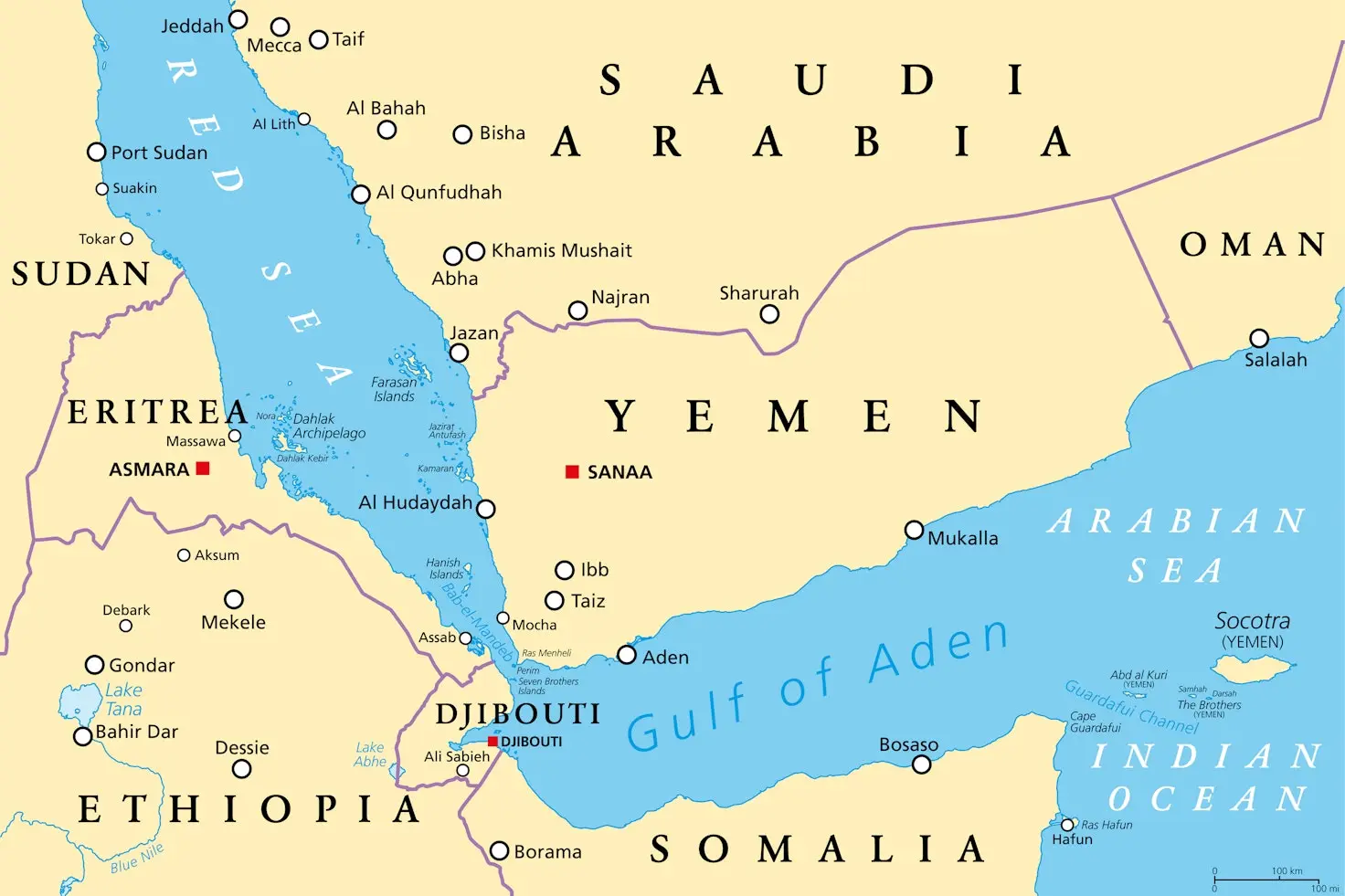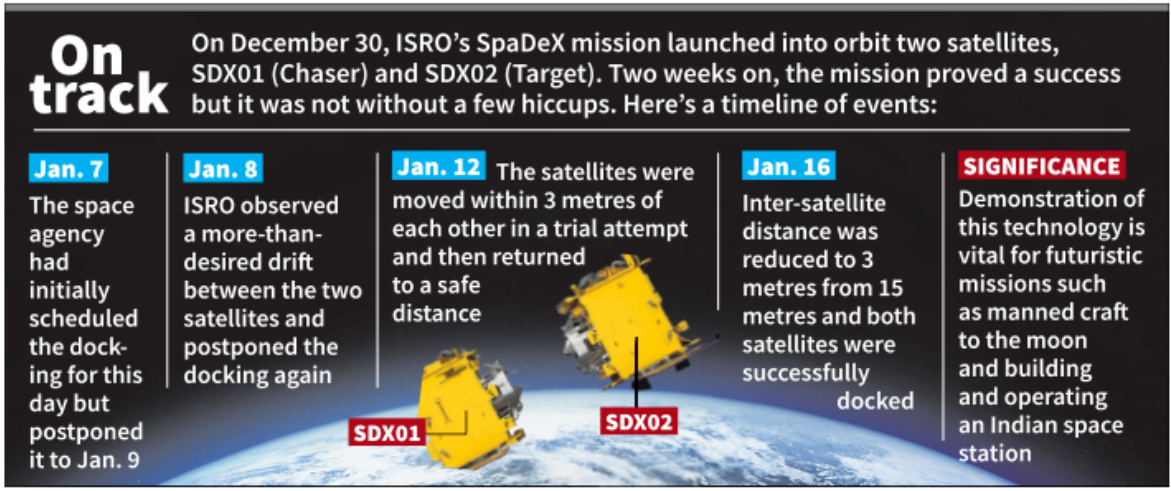Geography
Threats in Gulf of Aden and Red Sea could increase, says Defence Minister - The Hindu
Threats in the Gulf of Aden, Red Sea and in waters adjacent to the East African countries might increase and the Indian Navy is striving to boost its presence and keep the sea routes safe, the Indian Defence Minister said recently.
Gulf of Aden
- Location: Extension of the Indian Ocean between the Arabian Peninsula and the African continent.
- Extent: Approximately 900 km long, 500 km wide, covering about 410,000 sq km.
- Boundaries:
- South: Somalia and the Socotra Islands (Yemen).
- North: Yemen.
- East: Arabian Sea.
- West: Djibouti (narrowing into the Gulf of Tadjoura).
- Connections: Links the Red Sea to the Arabian Sea (and the Indian Ocean).
- Channels:
- Connected to the Somali Sea via the Guardafui Channel.
- The Strait of Bab el Mandeb connects it to the Red Sea.
- Division: Separated from the Arabian Sea by the Horn of Africa and Socotra Islands.
- Terrain: Sheba Ridge, an extension of the Indian Ocean ridge system, runs along its middle.
- Cities: Aden, Mukalla, Ahnwar, Balhaf, Berbera, Bosaso, Djibouti City.
- Ports: Aden (Yemen), Berbera and Bosaso (Somalia).
- Strategic Importance: Named after the port city of Aden (Yemen) & integral to the Suez Canal shipping route linking Red Sea & Mediterranean Sea.

Red Sea
- Location: Semi-enclosed extension of the Indian Ocean, between Africa and Asia
- Significance: World’s northernmost tropical sea and a major shipping route
- Connections:
- Linked to the Arabian Sea and Indian Ocean via the Gulf of Aden and the Bab el Mandeb Strait
- Bifurcated by the Sinai Peninsula into the Gulf of Aqaba and Gulf of Suez
- Connected to the Mediterranean Sea through the Suez Canal
- Geography: Surface area ~438,000 sq km, length ~2,250 km
- Bordering nations: Yemen, Saudi Arabia (east), Egypt (north and west), Sudan, Eritrea, and Djibouti (west)
- Climate: Among the warmest seas, with hot, salty seawater
- Unique Feature: Named after occasional red-brown coloration caused by algae blooms
- Islands:
- Tiran near the Gulf of Aqaba
- Shadwan at the entrance of the Gulf of Suez.
World Affairs
Russia, Iran sign treaty to deepen ties in the face of Western curbs - The Hindu
Russian President Vladimir Putin and his Iranian counterpart, Masoud Pezeshkian, signed a broad cooperation pact recently as their countries deepened their partnership in the face of stinging Western sanctions.
Cooperation Pact
- Comprehensive Strategic Partnership: Encompasses trade, military cooperation, science, education, and culture
- Key Projects:
- Expanding trade ties and gas shipments from Russia to Iran
- Building transport corridors to Iranian Gulf ports
- Overcoming technical obstacles through expert collaboration
- Russia-Iran Relations: Iran joined the BRICS bloc; sees Russia as a crucial partner
- Nuclear Cooperation: Russia built Iran’s first nuclear plant and is constructing two more
- Syria Situation: Joint efforts to back Bashar al-Assad’s government in Syria; failed to prevent Assad’s downfall; he fled to Russia
Engaging with the Taliban - Indian Express
Back in 2000, following a meeting with Mullah Abdul Salam Zaeef, the Taliban envoy to Pakistan, Vijay K Nambiar, India’s High Commissioner to Islamabad at the time, assessed the chances of engagement with the regime in Kabul as bleak. A quarter century later, India’s Foreign Secretary Vikram Misri last week led a delegation of senior Indian diplomats at a substantive meeting in Dubai with Amir Khan Muttaqi, Foreign Minister of the second Taliban regime.
First Contact in Doha
- August 31, 2021: India held its first official meeting with the Taliban in Doha.
- Participants: Ambassador Deepak Mittal met Sher Mohammad Abbas Stanekzai (an alumnus of the Indian Military Academy, Dehradun).
- Taliban’s stance: Stanekzai sought continued cultural, economic, political, and trade ties.
- India’s response: Then Foreign Secretary Harsh Vardhan Shringla described the engagement as “limited”.
Technical Team in Kabul
- September 2021: India effectively recognized Taliban as a state actor.
- December 2021: India sent 1.6 tonnes of essential medicines while distinguishing between the regime and the Afghan people.
- June 2022: An official Indian delegation visited Kabul to oversee the “delivery operations of our humanitarian assistance”.
- June 2022: Following a deadly earthquake in Khost and Paktika provinces, India stationed a “technical team” at the Kabul embassy to coordinate aid.
Afghan Embassy in Delhi
- December 2022: India voiced concern over the ban on women in universities.
- October 2023: Afghan embassy in New Delhi closed due to lack of resources & inability to “serve the best interests of Afghanistan.”
- January 2024: Indian diplomats in Kabul had their first publicized meeting with Foreign Minister Muttaqi.
Current Engagement
- Taliban’s Readiness: Indian officials sense the Taliban’s willingness for engagement and need for help in rebuilding infrastructure.
- India’s Stance: Keen not to lose out to other nations (e.g., China) making inroads in Afghanistan.
- Regional Dynamics:
- Iran is weakened.
- Russia is preoccupied with war.
- The US anticipates a potential Trump return.
- Pakistan has strained its ties with the Taliban.
- Security Concerns: India seeks to protect its past investments and ensure no anti-India terror groups operate from Afghan territory.
- Future Projects: India signals willingness to resume stalled projects in all 34 Afghan provinces.
Economy
NBM 2.0 aims to expand fiber to 2.7 lakh villages by 2030 - The Hindu
The Department of Telecommunications on Friday launched the vision document for the National Broadband Mission (NBM) 2.0, a follow-up to the previous NBM released in December 2019.
National Broadband Mission
- Launch: Initiated by the Ministry of Communications
- Aim: To ensure universal, equitable broadband access across whole India.
- Policy: Part of the National Digital Communications Policy (2018) to enable digital empowerment through affordable broadband access.
- Current Reach: Through BharatNet, broadband services have already extended to 1.42 lakh village blocks.
- Key Features & Objectives
- Broadband Access to all villages by 2022.
- Improve mobile and internet service quality significantly.
- Develop a measure to assess digital infrastructure.
- Create a comprehensive map of optical fiber cables and towers nationwide.
- Lay an additional 30 lakh route km of Optical Fiber Cable by 2024.
- Increase tower density from 0.42 to 1.0 per thousand population by 2024.
- Work with States/UTs to streamline Right of Way (RoW) approvals for laying optical fiber.
- Mobilize Rs 7 lakh crore, including Rs 70,000 crore from the Universal Service Obligation Fund (USOF).
NBM 2.0 Launch & Goals
- Objectives:
- Enhance fibre coverage in rural areas
- Raise fixed internet speeds
- Improve right-of-way for telecom infrastructure
- Key Targets (by 2030):
- Increase “operational” fibre connectivity to 2.7 lakh villages (from 50,000 now)
- Connect 90% of key institutions (schools, anganwadis, public health centres, panchayat offices) via fibre
- Raise rural subscription share from 45% to 60%
QS future skills report frames the Indian challenge: Skills gap, low innovation mindset - Indian Express
India has been ranked second in terms of preparedness for jobs of the future including artificial intelligence (AI) and green skills, only behind the United States, in the QS World Future Skills Index 2025.
QS World Future Skills Index 2025
- Lower in Other Parameters:
- 40th in economic transformation
- 37th in workforce having future job skills
- Overall Ranking & Categories:
- Placed 25th across all indicators (skills-employer alignment, academic readiness, economic transformation)
- Classified as a “future skills contender”
- Top 10 (US, UK, Germany, Australia, Canada, etc.) are “future skills pioneers”
- QS Index: Compiled by Quacquarelli Symonds to assess how countries meet evolving demands of the global job market.
Indicators Measured by QS
- Skills Fit: Assesses how effectively countries equip graduates with employer-desired skills.
- Future of Work: Evaluates readiness to recruit for digital, AI, and green skills in emerging job roles.
- Academic Readiness: Gauges preparedness of a country’s education system for future work demands.
- Economic Transformation: Uses key parameters (investment, innovation) to determine readiness to support future work and skills growth.
India’s Performance
- Future of Work (2nd place): Ranks only behind the US, reflecting strong demand for digital, AI, and green skills.
- Skills Fit (last among top 30): Scored 59.1, the lowest among the leading 30 countries which highlights gap between India’s higher education output and rapidly evolving employer needs.
- Future-Oriented Innovation & Sustainability (worst performance): Scores 15.6 out of 100, lower than G7 (68.3), EU (59), Asia-Pacific (44.7), and Africa (25.4).
- Economic Transformation (40th place): High economic capacity but limited investment and innovation capacity.
- Academic Readiness (26th place): Score of 89.9, indicating moderate preparedness of India’s education system for future employment demands.
India’s Education System & Policymaking
- Curriculum Focus: Urges universities to embed creativity, problem-solving, and entrepreneurship in curricula, and strengthen industry partnerships.
- Policy Recommendations:
- Implement continuous and lifelong reskilling programs
- Align government strategies to ensure skilled workers remain relevant and productive.
Science and Technology
WHY SPACE WEATHER IS KEY TO THE SUCCESSFUL DOCKING OF SATELLITES - Indian Express
Just as weather on Earth determines whether a rocket can be launched or not, calm conditions and lightning-free skies are a must, space weather can make or break missions in space. Favourable solar activity, for instance, was key to the Indian Space Research Organisation (ISRO) successfully carrying out its first ever “docking mission”.
Space Weather
- Definition: Caused by the continuous flow of charged particles (solar wind) from the Sun’s outer atmosphere (solar corona).
- Speed & Reach: These winds can travel millions of kilometres per hour, extending across the solar system.
- Solar Activity Cycle: Fluctuations depend on an 11-year cycle tracked by sunspot counts; higher activity means more hazardous space weather.
- Current Phase: Began in late 2019, entered maximum in November 2023, and remains in a high-activity phase.
Impact on Satellites & Spacecraft
- Vulnerability in Space: Satellites and spacecrafts remain exposed to solar radiation and charged particles.
- Consequences of Solar Activity:
- Strong solar flares can blind sensors and disrupt electronic control systems.
- Coronal Mass Ejections (CMEs) can cause communication losses and positional errors.
- Challenges in Docking:
- Requires negligible relative velocity and precise alignment between spacecraft.
- Severe space weather adds uncertainties that complicate the procedure.
- Favourable Solar Conditions:During the SpaDeX docking, fewer sunspots reduced solar activity, minimizing near-Earth disruptions.
